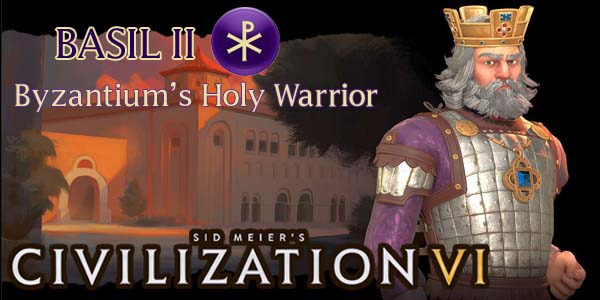
Firaxis has released the final update for its "New Frontiers" DLC Pass for Civilization VI. I have attempted to create guides for each new civilization included in the packs, but there is one civilization that I just didn't have time to cover when it was first released. That civilization was part of the September 2020 update, and it is the Byzantine Empire, lead by Basil II.

It looks like "New Frontiers" represents the end of the Civilization VI life cycle. If that is true, then don't fret. If I get enough demand from my Patrons, I'll also write guides for the "New Frontiers" game modes, or go back and create / update guides for legacy leaders. We also have new games such as Old World and Humankind coming out. I'll be playing both games when they release on Steam, and can also write guides for those games, if my supporters ask for it.
By the third century AD, the Roman Empire had expanded to control much of Asia Minor and the Eastern Mediterranean. The cities in the eastern Greek, Asia Minor, and eastern African provinces tended to be larger and more developed than settlements in the west, owing largely to the Greek and Macadonian empires that had preceeded Rome's occupation of the regions. This made these cities far wealthier than most western cities, and in 330 AD, Emperor Constantine relocated the Roman capital to the city of Byzantium due to its strategic location at the epicenter of trade routes between Europe and Asia, and between the Mediterranean and Black seas. The empire was later split into Western and Eastern administrative partitions, each with its own emperor. When Rome was sacked in 476 and the Western Roman Empire collapsed, the Eastern Empire in Constantinople continued to thrive.
It can be argued, thusly, that the Roman Empire survived until the fall of Constantinople to the Ottoman Turks in the 15th century. However, even though the Byzantine Empire can trace its authority directly to Imperial Rome, and it retained much of the legal and administrative framework inherited from the Roman Empire, eastern culture had begun to diverge from western culture before even the fall of Rome. Most citizens of the Eastern Empire may have considered themselves to be "Roman", but they spoke Greek instead of Latin. The architecture utilized ornate domes and spires as opposed to the austere columns, arches, and triangles of Latin architecture. Religious practices in the east also gradually transitioned away from the dogmatic practices of the Catholic Church until the Schism of 1054 formally established the Eastern Orthodox Church. It is, thus, equally accurate to say that the Byzantine Empire came to represent its own unique culture, independent of the Western Roman Empire.
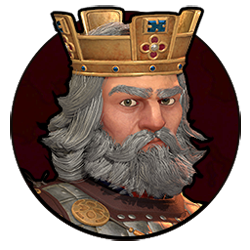
Basil II Porphyrogenitus was a life-long ruler of the Eastern Roman Empire. He was coronated as co-emperor along with his brother when he was just two years old, and ascended to the status of senior emperor at the age of 18, ruling until his death almost 50 years later. For most of his reign, he personally lead his armies into battle against Anatolian rebels, Bulgaria, the Fatimid Caliphate, and the Kingdom of Georgia, securing the empire's borders in both the west and east. Despite being away from Constantinople for so long, he also found time to distinguish himself as an administrator, reforming tax and property laws to protect poor land-owners from exploitation by wealthier elites. He also married off his sister to Vladimir I of Kiev, securing an alliance with the Kievan Rus and converting them to Orthodox Christianity. His reign was so successful, that the Empire prospered for decades after his death, despite his successor emperors being considered largely inept by both contemporary writers and modern historians. Though he is considered a national hero by the Greeks, he is known as "Basil the Murderer" by Bulgarians.
Basil II favors aggressive religious play backed up with a powerful mounted army and navy. He should seek to convert or conquer rival holy cities as soon as possible, then crush or convert his remaining rivals.
[More]
9717627d-e9ed-44d7-b203-9c3945c77bcd|2|5.0
Tags:Sid Meier's Civilization, Civilization VI, Byzantine Empire, Byzantium, Basil II, porphyrognnetos, taxis, hippodrome, tagma, dromon, Divine Guardian, entertainment complex, amenity, cavalry, heavy cavalry, navy, religion, holy city, prophet
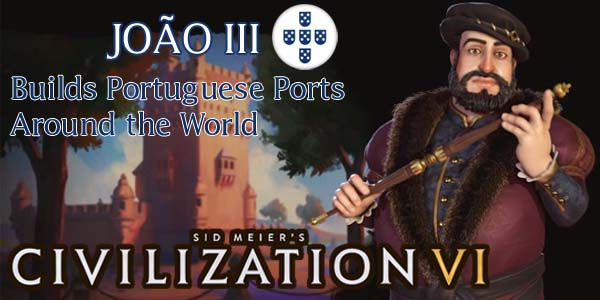
Firaxis has released the final "New Frontiers" update for Civilization VI. This update from March 2021 includes the new civilization Portugal, lead by João III.
If Firaxis decides to launch a second "New Frontiers" season, I will continue to write guides for the new civilizations and leaders. I will also put up polls on Patreon to let my Patrons decide which civ or leader to cover first (if Firaxis gives enough advance notice).

If "New Fontiers" is the end of the life cycle of Civilization VI, then don't fret. If I get enough interest from my Patrons, I'll also write guides for the "New Frontiers" game modes, or go back and create / update guides for legacy leaders. We also have new games such as Old World and Humankind coming out. I'll be playign both games when they release on Steam, and can also write guides for those games, if my supporters ask for it.
Portugal rose to prominence during the "Age of Discovery" in the 15th and 16th centuries, exploring the world and becoming the first global maritime empire. It established colonies and/or outposts in Brazil, Africa, India, and east Asia, it monopolized the spice trade, and was responsible for the formalization of the division of the globe into hemispheres. Portugal's dominion was short-lived however. A devastating earthquake in Lisbon in 1755, followed by occupation by Napoleonic France, and the eventual independence of Brazil combined to collapse the Portuguese maritime empire.
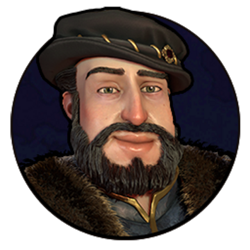
Portugal's maritime empire was laregely secured by King João III "The Pious" during his reign in the first half of the 16th century. João III established the first European colonies in Brazil and began importing Brazilwood into Europe, which was popular for creating red dyes. He was considered a scholar, humanist, and diplomat who supported the arts, granted scholarships to foreign universities, and remained neutral in wars between other European powers. But history is never so black-and-white, and João III is no exception. He also imported South American slaves into Europe from Brazil, and he boosted Portugal's relationship with the Vatican by allowing the Inquisition to establish itself in Portugal.
DISCLAIMER:
Civilization VI is still a "living game". Strategies for the game (and for specific leaders and civs) may change as Firaxis applies balance patches, introduces new features, or expands the game through further DLC or expansion packs, or as the Civ community discovers new strategies or exploits. As such, the following strategy guide may change from time to time. I will try to keep it up-to-date, and will make notations whenever changes are made. I'll also post links in the official 2K forums and CivFanatics, where I'll also report any changes made. If possible and practical, I will try to retain the original content of the strategy for posterity.
I welcome any feedback or suggestions that readers wish to offer. Feel free to post on the linked forums, or by posting a comment at the bottom of the page.
This guide is up to date as of the release of the [final] "New Frontiers" April 2021 Update (ver. 1.0.12.9)
João III explores the map to meet all other civilizations and city states, and will seek to establish peaceful trade relations with all of them, including constructing trade infrastructure in those other civilizations' cities. [More]
2a321222-ca59-47b4-8957-6177b584e9a1|0|.0
Tags:Sid Meier's Civilization, Civilization VI, Portugal, Portuguese, Joao III, casa da India, porta do cerco, navigation school, nau, caravel, feitoria, navigator's legacy, campus, navy, trade route, exploration, diplomacy, first contact
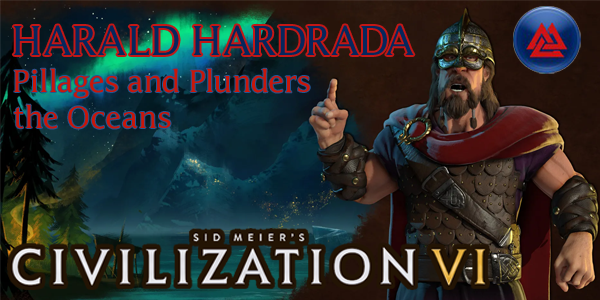
Now that I've covered all the civilizations which are new to the Civ franchise in the Gathering Storm expansion, I'm going to cover the other civs that my Patrons voted on. This guide will be for Viking King Harald Hardrada of Norway. Norway was included in the vanilla release of Civilization VI, but the strategies for playing as them (and all militaristic civs) changed considerably due to the loyalty mechanics introduced in the first expansion, Rise & Fall. The leader, Harald Hardrada, also had his Thunderbolt of the North ability enhanced by the Gathering Storm expansion.
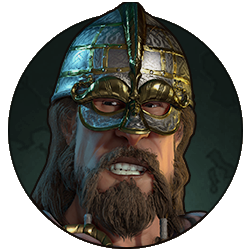
After the fall of the Western Roman Empire, migration out of the former Roman territories lead to a growth in population of the Scandinavian regions as the Medieval Warm Period made the frigid northern lands more amenable to agriculture. As populations grew, resources became scarce and piracy grew. The clans of Scandinavia began creating local or regional assemblies called "things", with the purpose of making laws, settling disputes, and directing the activity of pirates to territories outside of Scandinavia, eventually leading to a seasonal, sea-faring raiding culture. In 793 A.D., Norse raiders pillaged the English Catholic monastery at Lindisfarne, and kick-started the "Age of Vikings". Viking seafarers developed remarkably sea-worthy boats that allowed them to explore and colonize parts of the English isles, Iceland, Greenland, the Mediterranean, and they are even believed to have founded a short-lived colony in modern Canada.
The death of Harald Sigurdsson at the Battle of Stamford Bridge in England is often cited as marking the end of the Viking Age. Harald accumulated great wealth during his youth as a Byzantine Varangian Guard (a group of elite soldiers recruited from Northern Europe to protect the Eastern Roman Emperor). Upon returning to Norway, Harald inherited the throne from his nephew Magnus, and went on to unite Norway and institute a singular coinage economy that allowed Norway to enter into international trade. He earned the nickname "Hardrada" ("the hard ruler") for his stern rule, and propensity for using violence to put down internal opposition. He spent much of his life trying (unsuccessfully) to conquer Denmark before finally turning his attention to his fateful invasion of England.
DISCLAIMER:
Civilization VI is still a "living game". Strategies for the game (and for specific leaders and civs) may change as Firaxis applies balance patches, introduces new features, or expands the game through further DLC or expansion packs, or as the Civ community discovers new strategies or exploits. As such, the following strategy guide may change from time to time. I will try to keep it up-to-date, and will make notations whenever changes are made. I'll also post links in the official 2K forums and CivFanatics, where I'll also report any changes made. If possible and practical, I will try to retain the original content of the strategy for posterity.
I welcome any feedback or suggestions that readers wish to offer. Feel free to post on the linked forums, or by posting a comment at the bottom of the page.
This guide is up to date as of the release of the Gathering Storm expansion's "Red Death" (September 2019) (ver. 1.0.0.341)
Norway is an aggressive ocean-faring civilization that gets strong bonuses for raiding and pillaging. Their naval units can enter ocean tiles earlier in the game, allowing them to partially explore and settle other continents and meet distant civilizations sooner in the game.
[More]
1ac47dd8-bbc7-4458-ba2c-03bc2a17c30c|0|.0
Tags:Sid Meier's Civilization, Civilization VI, Norway, Viking, Harald Hardrada, knarr, thunderbolt of the north, berserker, stave church, Viking longship, last Viking king, navy, ocean, plunder, pillage, religion
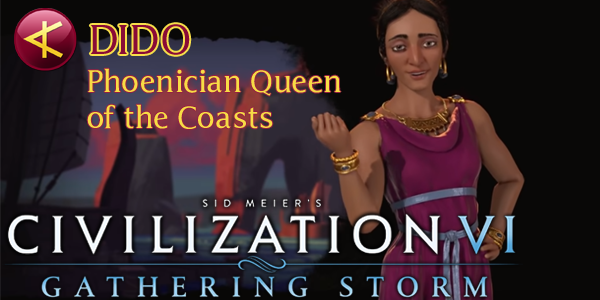
Civilization VI's second expansion, Gathering Storm released earlier this year and has added a handful of new civilizations and leaders. I am hoping to write a strategy for each of them, but I want to start with the civilizations and leaders who are completely new to the franchise. The final technically "new" civilization is Phoenicia. Phoenicia's leader, Dido has appeared in previous Civilization games as the leader of the Carthagenian civilization, but this is the first time that Phoenicia has been a civilization in the game.
Phoenicia never existed as a singular nation or empire, as the culture consisted of a collection of ancient, independent city states that built a vast Mediterranean trade network based on the export of dates, purple dyes, and textiles. The cities of Tyre, Byblos, and Sidon, on the Mediterranean coasts of modern-day Lebanon and Israel made up the core of the civilization, but colonies reached as far as Carthage in northern Africa and Cadiz in Spain. Phoenician ships were among the first to sail beyond the Strait of Gibraltar and begin exploring the Atlantic Ocean, and some fringe historians suggest that ancient Phoenicians may have made it as far as the southern tip of Africa, and maybe even to the Americas (though this is highly speculative).
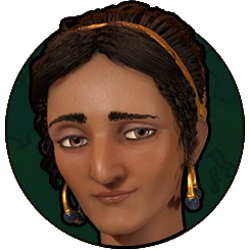
Dido is a semi-mythological figure who is regarded as the Mother of Carthage. Most historians agree that Dido existed, that she fled Tyre after a power struggle with her brother Pygmalion, and that she founded the cities of Byrsa and Carthage. There is, however, considerable disagreement about when and how it all happened. According to Virgil's Aeneid, Dido falls in love with Aeneas in Carthage after Aeneas flees the sacked city of Troy (much to the dismay of the Berber king who sought her hand in marriage). Aeneas is ordered by the god Mercury to leave Dido and settle in Italy, which he reluctantly does, and his sons Romulus and Remus would go on to found the city of Rome. Dido kills herself on a pyre and curses the descendants of Troy, thus establishing the rivalry between Rome and Carthage and foreshadowing the Punic Wars that ultimately resulted in the destruction of Carthage. Some traditions even say that Dido continues to haunt Aeneas forever in the underworld. This story contradicts the other accounts of Dido's death, in which Aeneas is never referenced, and Dido killed herself in the Pyre in order to escape marriage to the Berber King and remain faithful to her first husband. The truth is probably forever lost to the sands of time.
DISCLAIMER:
Civilization VI is still a "living game". Strategies for the game (and for specific leaders and civs) may change as Firaxis applies balance patches, introduces new features, or expands the game through further DLC or expansion packs, or as the Civ community discovers new strategies or exploits. As such, the following strategy guide may change from time to time. I will try to keep it up-to-date, and will make notations whenever changes are made. I'll also post links in the official 2K forums and CivFanatics, where I'll also report any changes made. If possible and practical, I will try to retain the original content of the strategy for posterity.
I welcome any feedback or suggestions that readers wish to offer. Feel free to post on the linked forums, or by posting a comment at the bottom of the page.
This guide is up to date as of the release of the Gathering Storm expansion's "September 2019 update" (ver. 1.0.0.341)
I debated with myself about whether to write a guide for Dido at this time, since I've already written a guide for her in Civ V, but I decided to go ahead and cover Phoenicia because it and Dido have some unique abilities that I was curious to play around with, and Firaxis added a new map type that potentially works well with her abilities. Dido is the only leader in Civilization VI who is allowed to willingly move her capital, and moving that capital actually does have some utility within the game.
[More]
1edd6e20-1d8b-42a9-961a-d8ff62814c56|0|.0
Tags:Sid Meier's Civilization, Civilization VI, Civilization VI: Gathering Storm, Phoenicia, Dido, Mediterranean colonies, founder of Carthage, cothon, bireme, Sicilian wars, navy, continent, palace, government plaza, trade routes, colonies, loyalty, ocean
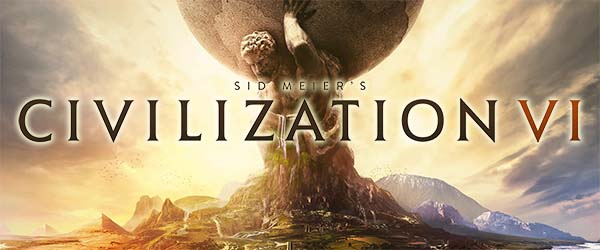
I really like Civilization VI! Of course, it has its share of nagging problems (some of which have been resolved already) - any game of this size and scope is likely to have issues at release. I've already been thinking of some ideas for how the game could be improved in expansions and DLC, and I'd like to spend a few posts to share some of those ideas with you now.
In my review of the game, I mentioned that oceans feel like they've regressed a bit since Beyond Earth: Rising Tide, in that they've returned to feeling like lifeless dead space on the map. Even though they're more important for Holy Sites and Campuses, mountains are also still mostly dead space on the map. They act as obstacles, and that's basically it. In expansions and DLC, I would like to see some of this space become more alive and useful. I'd like to spend this first suggestion post going over some ideas that I have for expanding the ocean mechanics, and for taking advantage of more of the map's dead space.
I have posted a link to this blog on Civfanatics at:
https://forums.civfanatics.com/threads/using-more-of-the-dead-space-in-the-map.610171/.
Feel free to discuss through the comments on this post, or via the linked forum topic!
Improve coastal cities
I'm very underwhelmed with coastal cities right now. Water tiles have very little utility. They provide small yield, can't have districts (other than a single harbor per city), and generally lack production. Coastal cities with lots of water are, thus, very unproductive and not really worth building. I think there's a couple ways to resolve this.
Harbors could provide a small amount of production. Or perhaps Harbors could act similarly to lighthouses from Civ V and provide production on sea resources. Or they could provide production on all adjacent sea tiles (so that placement is still important, and more of those empty sea tiles become useful and worth working, and you actually have to work them in order to get the benefit (as opposed to the Harbor just having an adjacency bonus). If we want to only use adjacency bonuses, then another alternative might be for Harbors to provide +1 production per adjacent coastal resource and +0.5 gold per adjacent water tile. That way, even cities that don't have clustered water resources can still have valuable locations for harbors.
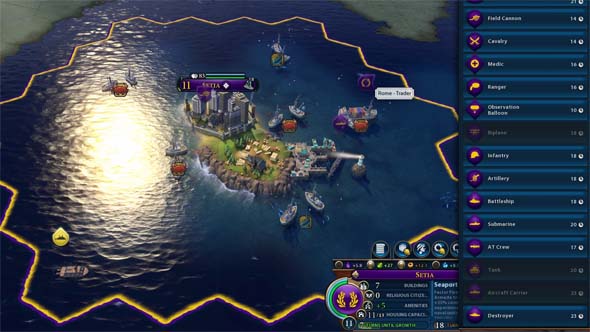
Coastal and island cities lack production and have limited space to build districts.
Another way to improve coastal cities would be to have some more early policies that benefit coastal cities. Perhaps the Maritime Industries policy could be changed to "+1 production in coastal cities, and +1 production from Harbors". Alternatively, Maritime Industries could be similar to the Veterancy policy, and it could provide "+33% production towards Harbor districts and buildings for that district". Or we could have policies that do both! A new policy could be added that provides the bonus production for early naval units. Maybe there can even be a whole extra early-game civic (maybe called "Seafaring" or "Way-finding") that has some policies and buffs towards coastal and island civilizations.
The lack of production for coastal cities could also be offset by giving them more gold and/or food for growth (in order to support a specialist economy)... [More]
0a6b7d05-286b-42c2-b6f9-dbbeca807f1a|1|5.0
Tags:Sid Meier's Civilization, Civilization VI, civilization, strategy, map, ocean, coast, beach, boardwalk, fishery, wind farm, island, mountain, observatory, astronomy, ski resort, tourism, tunnel, canal, navy, cities, Polynesia, way-finding, national park, naturalist, Civilization: Beyond Earth: Rising Tide
|

| 12 | | | | | | | 60 | | 11 | | | | | | | 55 | | 10 | | | | | | | 50 | | 09 | | | | | | | 45 | | 08 | | | | | | | 40 | | 07 | | | | | | | 35 | | 06 | | | | | | | 30 | | 05 | | | | | | | 25 | | 04 | | | | | | | 20 | | 03 | | | | | | | 15 | | 02 | | | | | | | 10 | | 01 | | | | | | | 05 |
|